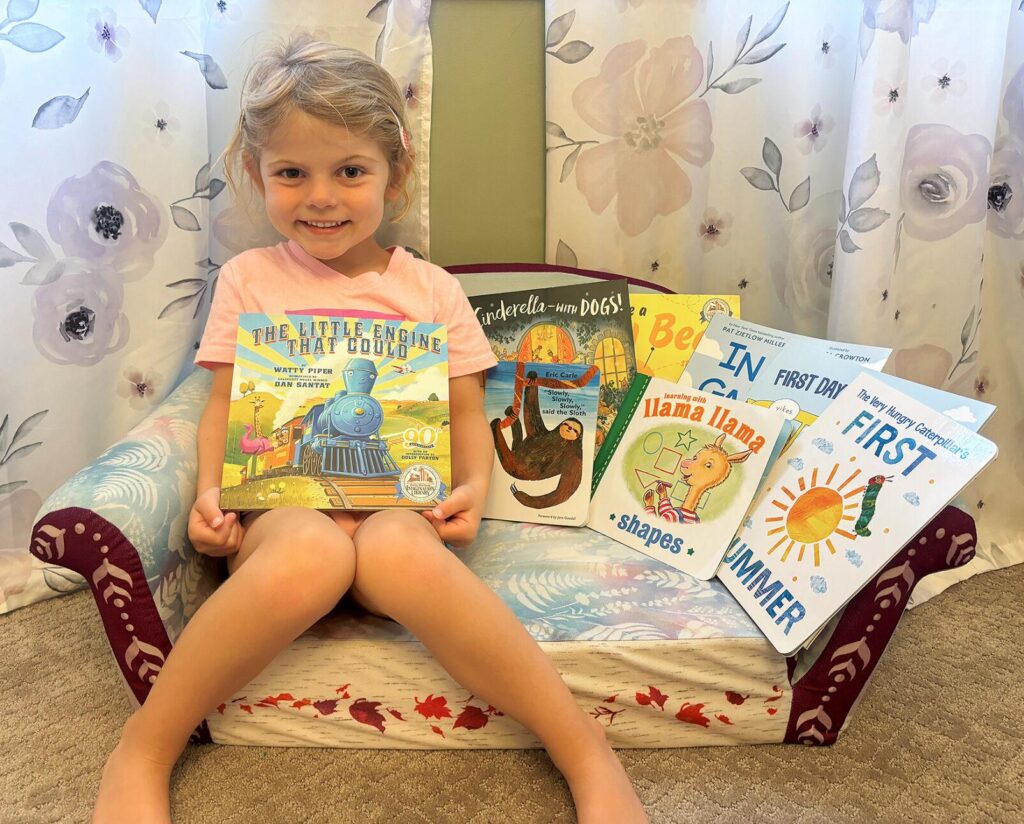Ada Caldwell, 4, poses with free books she’s received from the Imagination Library. (Courtesy of Tara Caldwell via Columbia Missourian)
By 2016, Imagination Library was sending a million books a month to children around the globe. In November, Missouri signed on to help fund the program and pledged to introduce books to children in all of the state’s 114 counties.By the end of June, 137,434 Missouri children like Ada had registered, and 751,730 books had been distributed.
If a child registers at birth and remains in the program for five years they could receive over 60 books for their home library, said Mallory McGowin with the Missouri Department of Elementary and Secondary Education.
Birth of the idea
Dolly Parton launched the Imagination Library in 1995. The first few books were only given to children in Sevier County, Tennessee, where Parton grew up. She created the program as a tribute to her father, who was not able to read.
“You can never get enough books into the hands of children,” Parton said in a statement on her website.
After the success of the program in 2000, a national replication was underway. By 2003 the program had mailed 1 million books throughout the U.S.
As the program continued, it spread to Canada, the United Kingdom, Australia and the Republic of Ireland, allowing children all over the world to have a special surprise waiting for them every month.
Today, the Imagination Library gifts over 2 million free books each month to children all over the world. As of April, more than 238 million books had been shipped worldwide.
How it works
Every county in Missouri has children enrolled in the Imagination Library of Missouri. Among those, 23 counties have more than 50% of the eligible children in their county enrolled, McGowin said.
Tara Caldwell, has two children enrolled in the program — Ada and Hazel, 10 months.
She registered her daughters the first day the statewide program went live Nov. 8.
“It was so many people signing up, and the site was busy, but I got them signed up right away,” Caldwell said.
Every book sent to a child is free, age-appropriate and personalized with the child’s name.
The first book her daughters received was “The Little Engine That Could,” a Dolly Parton favorite every child receives as their first book.
Caldwell said she is impressed that her daughters have been receiving individualized books for their age ranges, along with seasonal books.
Ada received books about gardening, bees and first-day-of school jitters, but her favorite is “Cinderella with Dogs,” a fun spin on the popular story Cinderella.
Hazel gets books tailored to toddlers, including “A Very Hungry Caterpillar’s First Summer,” a book about shapes, and couple of Eric Carle books.
Caldwell said she maintains the element of wonder with her daughters.
“You can look at the book list online but they never do, because I want it to be a surprise,” she said.
Which books and how do they choose?
The state Department of Elementary and Secondary Education has funding to administer the Imagination Library. There is no cost to schools or family, McGowin said.
The Dollywood Foundation selects and manufactures the books. The state covers the cost of the books for the children registered in Missouri as well as the cost to mail the books to their homes she said.
Every year, the Blue Ribbon Book Selection Committee, a specially selected panel of early childhood literacy experts, is responsible for reviewing hundred of potential titles for inclusion in the Imagination Library.
The committee is in charge of choosing books that meet the different need of children as they progress from birth to age 5.
Parents are encouraged to read the books as soon as they arrive and then repeat them multiple times while asking questions, pointing out letters and words, and noticing the sounds.
Science shows that the more kids interact with text at a young age and the more print-rich their environment is, the better equipped they are to read.
“Kids become better readers when they can talk about what they read,” said Rock Bridge High School Reading Specialist Daryl Moss.
It is important for them to understand that certain symbols are associated with different sounds and come together in ways that have further meaning,” he said.
“People use them to create words and those words create sentences.”
Many parents struggle with teaching their children how to read because things have changed since they were in school.
“It is not about teaching children how to read,” Moss said. “It is about bringing the joy of reading to them so they want to read more.”
This story originally appeared in the Columbia Missourian. It can be republished in print or online.

